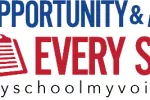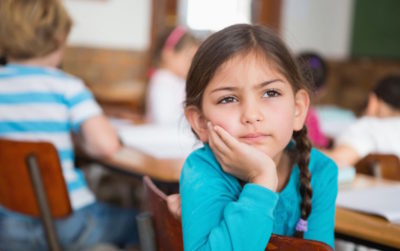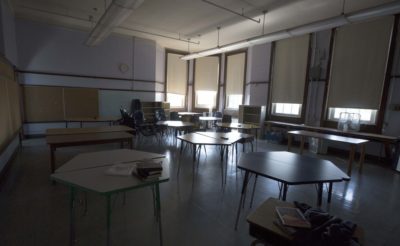
For public education, 2019, like previous years, brought its share of the good, the bad, and the ugly. On balance, there was plenty of good news, made largely possible by the 2018 mid-term elections that swept pro-education candidates into office. Much of that energy was drawn from the #RedforEd movement, which continued to generate momentum in calling for greater investments in public schools. As a result, educators and their unions head into the new decade stronger than ever.
Students are counting on it, because, as always, obstacles stand in the way of continued progress. Below we've listed a few that have undermined public education for too long. Some of them seem to be on the verge of receding completely from view. Others are more resilient, but educators and their allies will be working in 2020 and beyond to ensure that these lousy ideas, destructive policies, and outdated notions continue to fade from prominence.
Betsy DeVos’ Voucher Plan
 (AP Photo/Pablo Martinez Monsivais)
(AP Photo/Pablo Martinez Monsivais)
In her three years as U.S. Education Secretary, Betsy DeVos has focused on cutting education spending, championing school privatization, and weakening oversight into everything from civil rights protections for students to fraudulent student loans. DeVos has to be disappointed, however, that her pet project - a federal school voucher program called "Education Freedom Scholarships" - hasn't won much support on Capitol Hill.
But DeVos isn't giving up. She continues to travel the country pushing the proposal, which would allow individuals and companies to earn tax credits by donating money to nonprofit scholarship funds. Students can use these funds to attend private schools, including religious schools.
Any way you slice it, the program would "divert already scarce funding away from neighborhood public schools – where 90 percent of children go – and give it away to private schools, which are not accountable to taxpayers,” said NEA President Lily Eskelsen García.
DeVos recently touted the idea at a American Legislative Exchange Council conference in Arizona, a state that implemented a similar tax credit program called Education Savings Accounts (ESA) in 2015.
“Arizona is loving their ESAs,” DeVos said, ignoring the fact that voters in 2018 overwhelmingly rejected a ballot measure to expand the program.
(See also Betsy DeVos and her No Good, Very Bad Record on Public Education)
‘Money Doesn’t Matter’
 In 2018, Northwest University economics professor Kirabo Jackson told Chalkbeat that the debate whether increased funding actually improves student outcomes is “essentially settled.” In other words, of course it does.
In 2018, Northwest University economics professor Kirabo Jackson told Chalkbeat that the debate whether increased funding actually improves student outcomes is “essentially settled.” In other words, of course it does.
Bruce Baker of Rutgers University agrees. Reviewing the existing evidence in 2019, Baker acknowledged that money had to be spent wisely to produce better results, “but, on balance, in direct tests of the relationship between financial resources and student outcomes, money matters.”
This is the message that has driven the #RedforEd movement over the past two years. The actions taken by educators, parents, and students have been instrumental in winning substantial school funding increases in state after state. The general public hasn't wavered in its support. According to the 2019 PDK poll, 84 percent of parents would support a strike in their community for more school funding, and inadequate funding was named the greatest problem facing public education.
And yet, too many lawmakers across the country - not to mention the U.S. Education Secretary - are clinging to the notion that increased education funding is just “throwing money at schools,” underscoring the importance that educators and parents stay aligned in fighting for the schools our students deserve.
(See also: Educators Look to End the Big Corporate Tax Giveaway and Have Lawmakers Learned Anything From the Great Recession?)
‘Lunch Shaming’
 (USDA photo by Lance Cheung)
(USDA photo by Lance Cheung)
It's hard to believe, but children across the country are still denied nutritional meals in their school cafeterias because they have negative balances on their meal accounts. Outrage at so-called "lunch shaming" heightened in 2019. News stories of kids being forced to do chores in front of their peers and made to wear wristbands or hand stamps declaring their inability to pay went viral.
The good news is that we may actually not hear too much about lunch-shaming incidents in 2020. In addition to individual states passing their own laws banning the practice, a federal bill, the Anti-Lunch Shaming Act, is moving closer to becoming law. Supported by NEA, the bill will prohibit any school in the country from singling out children with lunch debt, while directing schools to address the issue of unpaid fees with parents or guardians only.
(Learn more about NEA’s priorities on child nutrition.)
Dress Codes That Discriminate
 Across the country, black girls are being singled out and punished in school for their clothing or appearance, including natural hairstyles. School dress codes often include bans on hair extensions, braids, and dreadlocks. While young black males are also victimized by these discriminatory practices, because their clothing is also often under the microscope, females are more likely to be "dress-coded" by school officials.
Across the country, black girls are being singled out and punished in school for their clothing or appearance, including natural hairstyles. School dress codes often include bans on hair extensions, braids, and dreadlocks. While young black males are also victimized by these discriminatory practices, because their clothing is also often under the microscope, females are more likely to be "dress-coded" by school officials.
The fixation on natural hairstyles is specifically troubling, Andre Perry wrote in The Nation: “Present-day efforts in schools to police and ‘fix’ black students’ hair is a vestige of our segregated past that deemed blackness inferior and the emulation of whites as the route toward assimilation.”
Spurred by student, parent, and educator activism, some states have taken concrete steps to address this inequity. Most significantly, California in July 2019 became the first state to explicitly ban discrimination based on natural hair in K–12 schools. Lawmakers did so by amending the CROWN Act - which prohibits workplace discrimination based on Afrocentric hairstyles - to protect students from similar discrimination in schools.
(See also: When School Dress Codes Discriminate and When Natural Hair Wins, Discrimination in School Loses.)
Leave it to the Machines
 A recent article in the Wall Street Journal detailed the disappointment Baltimore school officials felt when it became clear that the county's “one-to-one” laptop program didn't produce the anticipated improvement in student performance. In fact, results slipped a bit.
A recent article in the Wall Street Journal detailed the disappointment Baltimore school officials felt when it became clear that the county's “one-to-one” laptop program didn't produce the anticipated improvement in student performance. In fact, results slipped a bit.
This revelation shouldn't have been a surprise. Other districts have reached the same, and very expensive conclusion: going digital didn't really go anywhere.
Technology is a tool and a useful one, but it's not a panacea. Struggling districts looking to cut costs and improve student performance can be susceptible to aggressive and often dubious sales pitches by tech companies. According to a study by the National Education Policy Center, the marketing of many digital learning programs is based on “questionable educational assumptions, self-interested advocacy by the technology industry, serious threats to student privacy, and a lack of research support.”
As marketers and tech evangelists continue to champion the newest product with even more promises of student success, parents are increasingly wary about how all this “innovation” and “revolution” could ultimately transform the nation's classrooms,
“They fear that the business leaders want to cut costs by replacing expensive humans with inexpensive machines,” Diane Ravitch wrote in 2017. “They believe that education requires human interaction. They prefer experience, wisdom, judgment, sensibility, sensitivity, and compassion in the classroom to the cold, static excellence of a machine. I agree with them.”
(See also: Has the Personalized Learning Hype Worn Off?)
Arming Educators
 (Photo by Sebastiano Tomada/Sipa USA)
(Photo by Sebastiano Tomada/Sipa USA)
As of early December, there have been 45 school shootings in 2019. That comes to about about one school shooting a week.
The overwhelming majority of the public has called for sensible gun reforms. At the federal level, the House of Representatives has passed two background check bills supported by the NEA, but neither has been considered in the U.S. Senate.
Many opponents of these types of measures usually fall back on an idea that has been roundly denounced not only by educators and parents, but also most law enforcement groups: arming teachers and other school staff.
Most law enforcement experts agree that school staff should not carry guns because they lack the tactical knowledge of handling weapons that trained law enforcement personnel receive on a regular basis. Educators carrying concealed weapons simply pose too high a risk to school safety.
Unfortunately, six states continued to push this preposterous idea in 2019, while ignoring strategies - namely increased funding for mental health services - that actually could make a positive difference in reducing school violence.
(Learn more about NEA's efforts to reduce gun violence in schools)
A-F School Grading Systems
 (AP Photo/Scott Eisen)
(AP Photo/Scott Eisen)
Four years ago, President Barack Obama signed into law the Every Student Succeeds Act (ESSA) to replace No Child Left Behind. The new national education law has been a huge step forward for students. Among other provisions, ESSA allows individual states to design their own accountability systems to hopefully move away from the punitive “test and punish” regime that marred the NCLB era.
In July 2019, New Mexico received federal approval to move ahead with plans to replace the A-F school grading system that, using faulty test data, branded too many schools as “failing.”
Instead, said NEA-New Mexico President Mary Parr-Sanchez, the new plan “will ensure that the state and local school districts are measuring things that are important and highlight what is good about a school as well as what needs improvement.”
In Florida, where the system was pioneered, educators continue to call out the inherent unfairness of A-F school accountability.
“School grades are supposed to be a measure of success, but what they measure well is family income,” said Fedrick Ingram, president of he Florida Education Association. “They are part of a broken accountability system that has labeled and segregated communities for two decades.”
(See also: The Every Student Succeeds Act: Four Years Later, How Much Progress? and Community Schools Deserve Federal Support)
‘Stress is Just Part of the Job’
 In addition to spotlighting the urgent need to reinvest in public education, the #RedforEd movement has also drawn long overdue attention to the demands and pressures educators face every day.
In addition to spotlighting the urgent need to reinvest in public education, the #RedforEd movement has also drawn long overdue attention to the demands and pressures educators face every day.
Too many educators are burning out from workload pressure and other anxieties and are not receiving the support they need, particularly those newer to the profession. A 2016 study found that 46 percent of teachers report high daily stress, which is affecting their physical and mental health. Furthermore, high stress levels in teachers adversely impacts their students' academic performance. Research has also identified how student trauma leads to what is known as secondary traumatic stress (STS) - the emotional duress that can overtake educators who internalize their students' personal crises.
While many school leaders may still dismiss these conditions as “just part of the job” that educators have to deal with themselves, heightened awareness and understanding has prompted more districts to take action to support their staff.
“Stress isn't just affecting teachers,” says Steve Hydon, director of the School Social Work Program at the University of Southern California. “It’s also social workers, counselors, and psychologists, bus drivers, nurses, coaches, administrators. Everyone.”
(See also: ‘I Didn’t Know It Had a Name’: Secondary Traumatic Stress and Educators and Teacher Burnout or Demoralization? What’s the Difference and Why it Matters)


